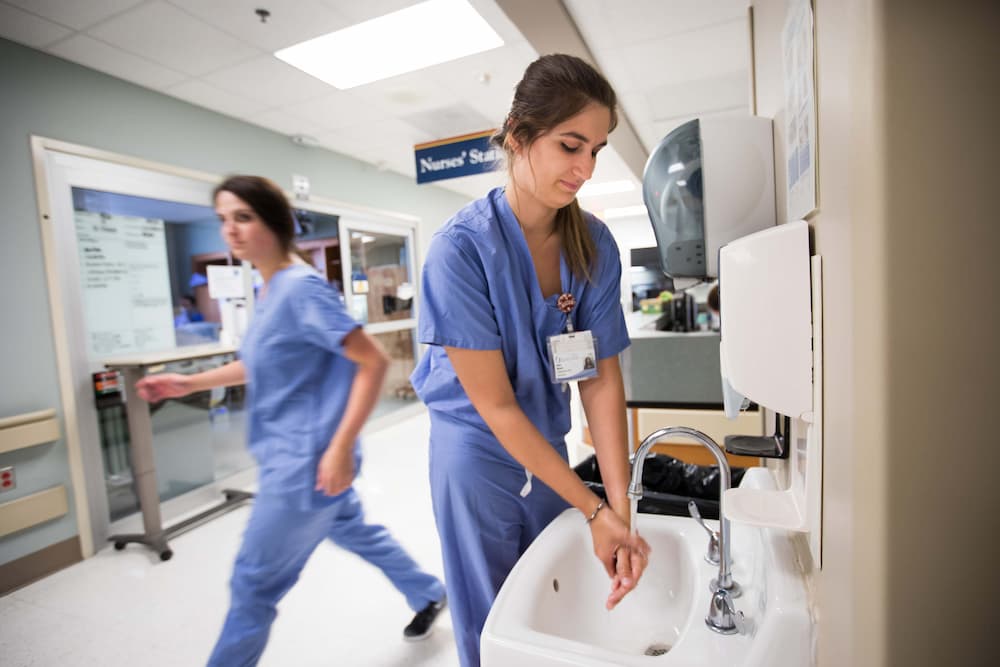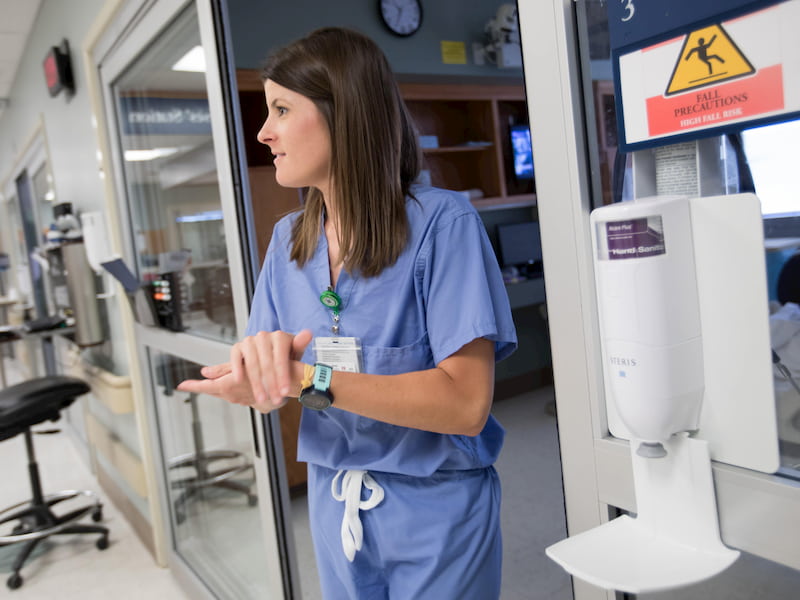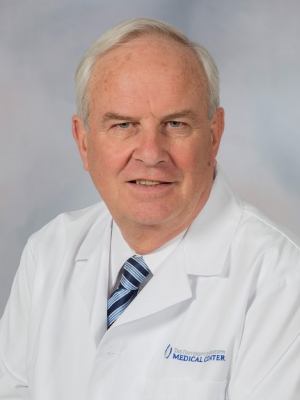Cross threshold, wash hands to protect patients, caregivers

Every day, front-line caregivers at the University of Mississippi Medical Center devote themselves to providing inpatients with medicines, procedures and education about their disease or illness.
They take or review their vital signs, evaluating factors that include blood oxygen levels, respiration, blood pressure and pulse.
But just as consistently, all caregivers who enter a patient room must wash their hands or use a foam cleanser every time they cross the threshold. It’s the best way to avert a patient becoming infected in the hospital, sometimes by a caregiver bringing bacteria from one room to a patient in another.
The Medical Center’s hand hygiene compliance rates, especially those in the adult hospitals, have slipped from a high of near 80 percent. In the first quarter of 2017, it stood at 77 percent -- but in the last three months has fallen to 68 percent, with one hospital floor dipping to a compliance rate of 49 percent.
The short-term target is 85 percent compliance for all hospital inpatient locations, with a current baseline of 73 percent.
“We should keep handwashing top of mind,” said Liz Youngblood, chief executive officer of the adult hospitals and UMMC’s clinics. “In time it can become routine practice, but it takes consistency in the process to ensure optimal patient outcomes.”
How often employees wash their hands is no secret. In fact, the numbers are transparent for all to view on the Medical Center’s Clinical Intranet. Click on the blue Safety/Quality box in the left-hand column, and you’ll see patient safety focus areas that include Hand Hygiene. Click Explore the Data in the upper right-hand corner, and see how individual departments and provider types are faring, broken down to year, month and location. For example, you can find the compliance rates at the level of hospital floors by clicking Patient Location.

There are wide differences in some patient care areas. For example, 2 North in August 2016 had a hand hygiene compliance rate of 38.24 percent, improving to 55.56 percent in August 2017. The NSICU had an 85.93 percent compliance rate in August 2016, staying steady for the next year and posting an 82.81 percent rate in August 2017.
The compliance rates are based on data collected by consistent observation by trained personnel charged with walking the hospital floors. Their job: to coach all employees respectfully in hand hygiene best practices, and to help them overcome any barriers they encounter on the job that keep them from consistently washing their hands.
It’s called Just in Time coaching, and it targets all employees. Physicians and residents are held just as responsible for washing their hands as are nurses or anyone else who enters a patient’s room.

“Our huge variabilities are in the adult hospitals,” said Dr. Michael Henderson, the Medical Center’s chief medical officer. “The metrics are way behind.”
Some employees aren’t as serious as they should be about hand-washing or foaming in and out because they don’t trust the data, or don’t understand how it’s gathered, Henderson said. There have been some recent changes in the observation process to improve data collection, he said.
“On review, we recognized that previously there were more observations in higher-performing areas” such as Batson Children’s Hospital, he said. “The observations are now more evenly balanced across all locations.”
The group of confidential observers has been reduced and re-trained to ensure consistency in data gathering, Henderson said. “We no longer include self-reported observations.”
For the last reporting period, he said, only two units in the adult hospital had compliance rates of over 65 percent. That translates into caregivers on some floors not washing their hands 35 percent of the time when they enter or leave a patient room.
And, hand hygiene doesn’t apply only to those giving direct care. It extends to dietary employees who bring in food trays, transport employees who ferry patients from room to room, and case managers verifying information. It includes medical students or residents who may not touch a patient, but who have crossed the patient room’s threshold.
Hand hygiene compliance can come into play in the Medical Center’s rate of hospital acquired infections. The hospital-wide baseline for those infections, including surgical site infections, MRSA bloodstream infections, and urinary tract infections, is 38 per month. But, the target is 18.
One thing hasn’t changed, and won’t change. “Foaming in and out remains the standard for every patient, every time,” Henderson said. “When you go into a patient room, you must wash your hands. When you’re good at it, you don’t think about it. You just do it.”
Myrtle Tate, charged with Just in Time training as part of UMMC’s Performance Improvement team, regularly meets with nurse managers to talk out any hand hygiene challenges and to discuss ways to ramp up compliance. Recently, Tate took employees attending the Medical Center’s Sept. 13 Leadership Meeting through an exercise in which they had to coach the person sitting next to them as if they’d observed them not washing their hands.

“They gave us different scenarios, and we chose one and walked back and forth through it,” said Henry Cote, assistant manager for materials management supply chain. “I could put myself in their position, and see that it might seem strange for someone in housekeeping to say something to a physician or resident about not washing their hands. But, everyone needs to wash their hands.”
He’s noticed a lapse in hand hygiene in some of the units he visits when bringing supplies, Cote said. “I always saw hands rubbing together, but you don’t see it as much now,” he said. ”There’s soap all over the hospital. You can’t turn a corner without seeing it.”
Work with Just in Time coaches “to help you overcome barriers to hand hygiene,” such as being too busy, carrying items in your hands or simply forgetting, Henderson says. “Hand hygiene is not always easy.
“This phase of our hand hygiene journey is as much about culture and our willingness to help each other as it is about a physical act,” he said. “When this seems hard, always remember that we are doing this for our patients.”

